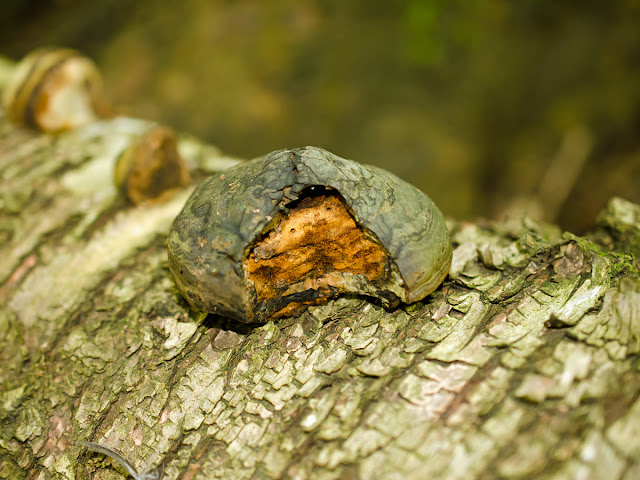Near the top of the hill over the Campbell River canyon, they've recently cut down a tree. I stopped to read its history. Written in tree runes.
 |
| Quite a varied life it has lived! |
Okay, the basics: a cross-section of a tree trunk shows 5 main zones.
- The outer bark. Here seen as a black line, just under the moss. This is dead wood, serving as a protective layer.
- The inner bark, the phloem. This is the narrow zone just beneath the bark; here water and nutrients (sugars, mostly) flow from the leaves to the rest of the tree, going both up and down, as needed.
- The cambium. This is the growing part of the tree, renewing itself annually. The outer edge produces phloem cells, and the inner cambium produces xylem cells, which become ...
- ... the sapwood. This is new wood; here water and nutrients move upwards from the roots to the leaves. Here is where the annual rings are formed; the wood is lighter, less dense in the summer, and darker, denser when growth slows in the winter.
- And finally, the heartwood. This, again, is dead wood, and serves as the strong support holding the tree upright.
But this trunk has a bit more history to tell.
 |
| Rings and squiggles and painterly zones. |
What's happening here? There's that bright, yellowish area; it doesn't go all the way around the trunk. There are several growth rings apparent, and beyond it, there's that dark line that looks like it should be bark.
Sometimes a tree's situation changes as it grows. Other trees grow up and shade it, where it used to receive sunlight. Or another tree will fall against it, causing it to lean over. Or it may be subject to high winds, creating more resistance on the windward side. Sometimes, then, the tree forms new wood on one side, building up strength where it is needed for support. This may be what has happened here.
Then there are those black lines separating dark wood from lighter wood. These are the borders of individual fungal colonies. The lines themselves are caused by an accumulation of fungal and plant chemicals. We would normally see the fungi as those shelf fungus that sprout on the bark, but most of the fungal activity is hidden here, inside the trunk.
 |
| Detail, fungal zone lines. |
Then there is a section near the centre of the stump, where the wood is darker and full of holes. It could be insect damage, or maybe a dry rot fungus.
 |
| View from the other side, the slow-growing side. |
 |
| Detail of annual growth rings and fungal zone lines. |
~~~~~~~~~~~~~~
Cerca del puente que cruza el cañón del rio Campbell, recientemente han cortado un árbol al lado del sendero. Me detuve para leer su historia. Escrita en runas.
Foto #1: Ha vivido una vida llena de cambios.
Bueno, empezamos con lo básico: una sección transversal de un tronco de árbol muestra 5 zonas principales.
- La corteza exterior. Aquí se ve como una linea negra, cubierta de musgo. Esta es madera muerta, y sirve para proteger la madera viva.
- La corteza interior, o sea, la floema. Esta es la zona angosta debajo de la corteza muerta. En esta zona, agua y nutrientes, por la mayor parte azúcares, fluyen desde las hojas hasta la madera del árbol, subiendo o bajando como lo exige la situación.
- El cambium. Esta es la parte del árbol donde sigue creciendo, formando una nueva capa cada año. La zona exterior produce células de floema, y en el interior son producidas las células de xilema, que forman parte de ...
- ... la albura. Esta es madera nueva; aquí agua y nutrientes suben desde las raices hasta las hojas. Aquí se forman los anillos anuales; la madera es más clara, menos densa en el verano, y oscura y densa cuando el crecimiento disminuye en el invierno.
- Y finalmente, la madera dura. Esta es madera muerta, sirviendo como el soporte que mantiene el árbol en pie.
Pero este tocón de árbol nos cuenta algo más de su historia.
Foto #2: Anillos y curvas y zonas pintadas. ¿Qué pasa aquí? Hay esa zona amarilla, que no rodea por completo el tronco. Se ven algunos de los anillos anuales, y luego esa zona café oscuro que parece que debería ser corteza.
A veces el ambiente del árbol cambia durante su vida. Otros árboles crecen y le quitan la luz. O otro árbol le cae encima, haciendo que se incline hacia un lado. O le azotan vientos fuertes, creanod una resistencia en el lado expuesto. A veces, en estas situaciones, el árbol desarrolla más madera de un lado para sostenerse. Esto puede ser lo que pasó aquí.
Y luego se ven esas lineas negras que separan diferentes zonas de madera. Estas denotan los bordes de colonias individuales de hongos y son el resultado de una acumulación de sustancias químicas producidas por los hongos. Normalmente, vemos los hongos como esos políporos que brotan desde la corteza, pero de hecho, la mayor parte del hongo se esconde aquí dentro de la madera.
#3: Detalle, mostrando las lineas de las zonas de hongo.
Y hay un area cerca del centro del tocón, donde la madera es de color oscuro y tiene muchos hoyos. Puede ser trauma causada por insectos, o causado por el hongo podredumbre seca.
#4: Vista del tocón desde el otro lado.
#5: Detalle de anillos anuales y lineas de zona de hongos.















































